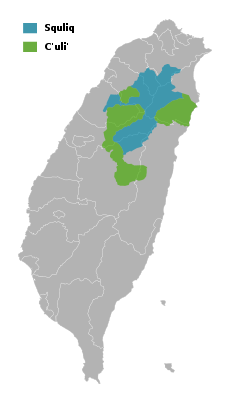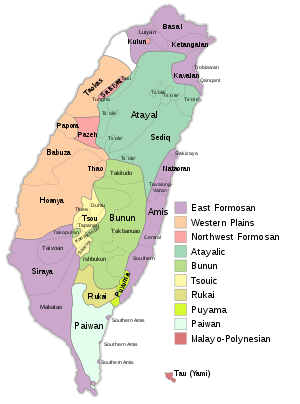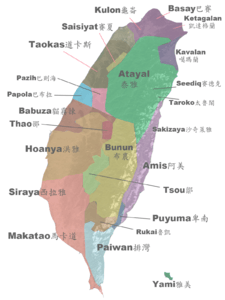Atayal language
| Atayal | |
|---|---|
| Tayal | |
| Region | north Taiwan |
| Ethnicity | Atayal people |
Native speakers | 84,000 (2002)[1] |
| Latin | |
| Language codes | |
| ISO 639-3 |
tay |
| Glottolog |
atay1247[2] |
| Atayal language test of Wikipedia at Wikimedia Incubator |
The Atayal language is spoken by the Atayal people of Taiwan. Squliq and C’uli’ (Ts’ole’) are two major dialects. Mayrinax and Pa’kuali’, two subdialects of C’uli’, are unique among Atayal dialects in having male and female register distinctions in their vocabulary.
The language is recorded in an Atayal–English dictionary by Søren Egerod and several reference grammars. The Bible has been translated into Atayal and was published in 2002. Atayal is written in the Latin script. Atayal was one of the source languages of Yilan Creole Japanese.
Orthography
The Atayal language is most commonly written in the Latin script. ⟨ng⟩ represents the velar nasal /ŋ/, and the apostrophe ⟨'⟩ represents the glottal stop. In some literature, ⟨ḳ⟩ is used to represent /q/ and ⟨č š ž⟩ are used to represent /tʃ ʃ ʒ/.
In some dialects but not all, schwa /ə/ is frequently omitted in writing, resulting in long consonant clusters on the surface (e.g. pspngun /pəsəpəŋun/).[3]
The pronunciation of certain letters differs from the IPA conventions. The letter ⟨b⟩ represents /β/, ⟨c⟩ is /ts/, ⟨g⟩ is /ɣ/, ⟨y⟩ is /j/, and ⟨z⟩ is /ʒ/.
Phonology

Dialects differ slightly in their phonology. Presented below are the vowel and consonant inventories of Mayrinax Atayal (Huang 2000a). Orthographic conventions are added in <angle brackets>.
Vowels
| Front | Central | Back | |
|---|---|---|---|
| High | i | u | |
| Mid | e | ə | o |
| Low | a |
Consonants
| Bilabial | Alveolar | Palato- alveolar |
Palatal | Velar | Uvular | Pharyngeal | Glottal | ||
|---|---|---|---|---|---|---|---|---|---|
| Stop | p | t | k | q | ʔ | ||||
| Affricate | ts <c> | ||||||||
| Fricative | Voiceless | s | x | ħ <h> | |||||
| Voiced | β | ɣ <g> | |||||||
| Nasal | m | n | ŋ | ||||||
| Trill | r | ||||||||
| Semivowel | w | j <y> | |||||||
Most of these sounds are also encountered in other Formosan languages, but the velar fricative [x] is a trade mark of Atayalic languages. This sound has restricted distribution, though, as it never occurs in word-initial position.
Even though some literature includes a glottal fricative in the consonant inventory, that phoneme is phonetically realized as a pharyngeal (Li 1980), which is true for Atayalic languages in general. The alveolar fricative (s) and affricate (ts) are palatalized before [i] and [j], rendering [ɕ] and [tɕ], respectively (Lu 2005), as in the Sinitic contact languages Mandarin Chinese and Taiwanese Hokkien.
Plngawan Atayal (a subdialect of Ci'uli') differs from this inventory in that it lacks a schwa (ə), and that there are two phonemic rhotics (Shih 2008).
Squliq Atayal has a voiced alveo-palatal fricative [z] (Li 1980), but Huang 2015 doubts its phonemicity, arguing that it is an allophone of [y].
Grammar
Verbs
Mayrinax Atayal (a Cʔuliʔ dialect spoken in Tai'an Hsiang Township, Miaoli County) has a four-way focus system (Huang 2000b).[4]
- Agent focus (AF)
- Patient focus (PF)
- Locative focus (LF)
- Instrumental/Beneficiary focus (IF/BF)
The following list of focus markers are used in Mayrinax Atayal.
- Agent focus (AF)
- Realis: m-, -um- (more dynamic); ma-, ø (less dynamic / more stative)
- Irrealis: m-, ma-, -um- ... -ay (projective/immediate); pa- (future)
- Patient focus (PF)
- Realis: -un (neutral), ø (perfective)
- Irrealis: -aw (projective/immediate); -un (future)
- Locative focus (LF)
- Realis: -an
- Irrealis: -ay (projective/immediate); -an (future)
- Instrumental/Beneficiary focus (IF/BF)
- Realis: si-
- Irrealis: -anay (projective/immediate); ø (future)
Aspect markers include:[4]
- -in-: perfective
- pa-: irrealis (also serves as a causative marker)
- kiaʔ and haniʔan: progressive
Other verbal markers include:[4]
- ka-: stative marker
- i-: locative marker
- ø- (null marker): agent-focus imperative
Dynamic and stative verbal prefixes run along a continuum. Here, they are listed from most dynamic to most stative.[4]
- m-, -um-
- ma1-, ø1
- ma-2
- ø2
Case markers
Mayrinax Atayal has an elaborate case marking system. The Mayrinax case markers below are sourced from Huang (2002).
| Case | Nominative | Accusative | Genitive/ Oblique |
Comitative |
|---|---|---|---|---|
| Proper noun | ʔiʔ | ʔiʔ | niʔ | kiʔ |
| Common noun (referential) |
kuʔ | ckuʔ | nkuʔ | - |
| Common noun (non-referential) |
aʔ | cuʔ | naʔ | - |
Wulai Atayal (a Squliq Atayal dialect spoken in Wulai District, New Taipei City) has a much simpler case-marking system (Huang 1995).
| Case | Nominative | Instrumental | Genitive | Comitative | Locative |
|---|---|---|---|---|---|
| Markers | quʔ | naʔ | naʔ, nquʔ | kiʔ | te, squʔ, sa |
Pronouns
The Mayrinax and Wulai Atayal personal pronouns below are sourced from Huang (1995). In both varieties, the nominative and genitive forms are bound while the neutral and locative ones are free (unbound).
| Type of Pronoun |
Nominative | Genitive | Locative | Neutral |
|---|---|---|---|---|
| 1s. | sakuʔ, kuʔ | makuʔ, mu, kuʔ | knan | kuzing, kun |
| 2s. | suʔ | suʔ | sunan | isuʔ |
| 3s. | - | nyaʔ | hiyan | hiyaʔ |
| 1p. (incl.) | taʔ | taʔ | itan | itaʔ |
| 1p. (excl.) | sami | myan | sminan | sami |
| 2p. | simu | mamu | smunan | simu |
| 3p. | - | nhaʔ | hgan | hgaʔ |
| Type of Pronoun |
Nominative | Genitive | Neutral |
|---|---|---|---|
| 1s. | cu, ciʔ | mu, miʔ | kuing |
| 2s. | suʔ, siʔ | suʔ | isuʔ |
| 3s. | - | niaʔ | hiyaʔ |
| 1p. (incl.) | taʔ, tiʔ | taʔ, tiʔ | itaʔ |
| 1p. (excl.) | cami | niam | cami |
| 2p. | cimu | mamu | cimu |
| 3p. | - | nhaʔ | nhaʔ |
Affixes
The following list of Mayrinax Atayal affixes is sourced from the Comparative Austronesian Dictionary (1995).
- Note: Some affixes are unglossed.
- Verbal prefixes
- ma- 'stative'
- ma- 'active'
- man-
- mana-
- maɣ-
- ma-ša- 'reciprocal, mutual'
- ma-ši 'natural release or movement'
- pana-
- ma-ti-
- ʔi-
- pa- 'causative'
- ši- 'benefactive'
- ga- 'verbalizer'
- kan- + RED + N (body parts) 'body movement'
- ma-ka- 'mutual, reciprocal'
- maki- 'active verb'
- mat- 'to turn'
- mi-
- paš-
- ta- ... -an 'location'
- tiɣi- 'to release gas'
- tu- 'for some to ... '
- Verbal infixes
- -um- 'agent focus'
- -in- 'completive'
- Verbal suffixes
- -an 'locative focus'
- -un 'object focus'
- -i 'imperative'
- -aw 'future or mild request'
- -ani 'polite request'
- Nominal affixes
- -in- 'nominalizer'
- -in- ... -an 'nominalizer to indicate a completed action'
- Male affixes (i.e., male forms of speech in Mayrinax Atayal) include (Comparative Austronesian Dictionary): -niḳ, -iḳ, -ʔiŋ, -hiŋ, -iŋ, -tiŋ, -riʔ, -ḳiʔ, -niʔ, -nux, -ux, -hu, -u, -al, -liʔ, -kaʔ, -ha, -il, -in-, -il-, -i-, -a-, -na-.
See also
Notes
- ↑ Atayal at Ethnologue (18th ed., 2015)
- ↑ Hammarström, Harald; Forkel, Robert; Haspelmath, Martin, eds. (2017). "Atayal". Glottolog 3.0. Jena, Germany: Max Planck Institute for the Science of Human History.
- ↑ Rau, D. V. (1992). "A Grammar of Atayal". Cornell University dissertation. pp. 22–23
- 1 2 3 4 Huang, Lillian M. (2000b). Verb Classification in Mayrinax Atayal. Oceanic Linguistics, Vol. 39, No. 2 (Dec., 2000), pp. 364-390.
References
- Huang, Lillian M. (1995). The syntactic structure of Wulai and Mayrinax Atayal: a comparison. Bull. National Taiwan Normal University, Vol. 40, pp. 261–294.
- Li, Paul Jen-kuei (1980). The phonological rules of Atayal dialects. Bulletin of the Institute of History and Philology Academica Sinica, Vol 51(2), pp. 349–405.
- Rau, D. V. (1992). "A grammar of Atayal". Cornell University dissertation. Describes Squliq Atayal.
- Shih, P. (2008). Interrogative Constructions in Plngawan Atayal. MA thesis. Taiwan: National Taiwan Normal University.
- Valle, G. D. (1963). Handbook of Atayal, as it is spoken in Wufeng (Hsinchu hsien). Taichung: Kuangchi Press
- Mayrinax Atayal
- Huang, Lillian (2000a). "泰雅語參考語法" [Atayal language reference grammar]. Taipei: Yuanliou. Describes Mayrinax Atayal.
- Huang, Lillian M. (2000b). Verb Classification in Mayrinax Atayal. Oceanic Linguistics, Vol. 39, No. 2 (Dec., 2000), pp. 364–390.
- Huang, Lillian M. (2001). Focus system of Mayrinax Atayal: a syntactic, semantic and pragmatic perspective. Journal of Taiwan Normal University: Humanities and Social Science. 2001, 46(1,2), pp. 51–69.
- Huang, Lillian M. (2002). Nominalization in Mayrinax Atayal. Taipei: National Taiwan Normal University.
- Lu, Anne Yu-an (2005a). Order and Interaction of Prefixes in Mayrinax Atayal. Hsinchu, Taiwan: National Tsing Hua University.
- Lu, Anne Yu-an (2005b). Mayrinax Phonology: With Special Reference to UM Affixation. MA Thesis. Taiwan: National Tsing Hua University.

